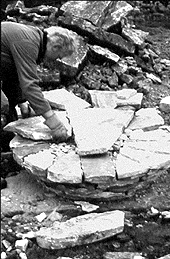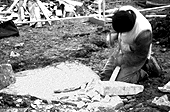| Sheepfolds to Visit | |
News | Education | Images | Accessibility | Search | Links |
|
|
Some notes from Andy Goldsworthy's lecture at Tullie House, Carlisle, 24th February 2000 The project has changed over the years since its inception in 1996, in particular, in terms of my increasing respect for the skills of the wallers and the traditions of walling and sheep farming ... Although each fold is an individual piece, the project should be seen as a single work of art ... The more I have become involved with sheep, the more aware I have become of the powerful effect that they have had on the landscape. I have developed a concept of history made by sheep! I am also interested in the relationship between sheep and walls, their contrast in movement and the effect of one upon the other. There is a sense of continual counterpoint between these two elements ... As a sculptor, I have learnt a great deal from the way in which a wall is made and placed. The line it takes draws and defines the place through which it travels - the wall finds the best route. Walling is like lines drawn out of a place, not imposed on the land. These lines form junctions, enclosing space and made over time ... Walls can incorporate other elements within them - a rock or a tree - or enclose them. I want to use this aspect in some of my work. This was one of my intentions in building the wall in Grizedale, walking it round the trees. The original wall was no longer necessary as a boundary because of the new use of the land for forestry and its remains were, therefore, evidence of change and decay ... I wonder whether any work is really permanent or am I actually dealing with time? To this extent, the sheepfolds link my earlier ephemeral work to the more permanent. However, the ephemeral is still the life blood from which I get my ideas for the permanent. I get to know a new place through sticks, stones, leaves etc ... I am now interested in embedding ideas and forms from earlier work into the sheepfolds to show where my art has come from. This happens in 2 ways. First are the temporary works I made in sheepfolds I found when following Coleridge's walk around the Lakes. Secondly, I am planning folds like the 'Shadow stone fold' at Tilberthwaite or the 'Riverstone Thoughts' at Deadman's Gill, which will incorporate and celebrate some of my earlier temporary work ... My forms are influenced by the agricultural environment in which I work. This puts my work into the context of things which have gone before. They become yet another layer which makes the place richer and, in doing this, the sheepfold becomes a forum for a story or an idea - it is charged with the memory of what has happened in there ... But the landscape has a rhythm and structure within itself. We need to look and touch to find this structure. Until I touch I don't understand. It is like the waller who doesn't just see a pile of stones in the corner of a field - he sees the wall waiting to be built within it. This is what I wanted to express in the Mungrisdale 'Field-Boulder Fold' ... With the Casterton folds, I wanted to follow a journey like the sheep that followed the old drove road. We might pass by the first fold, but by the second or third might think, 'that's strange', and by the sixteenth all sorts of ideas are developing. The stones too have travelled on a journey from the quarry into the city and then into the buildings ... The notion of growth is another important idea in my work. For example, the cones I make are built layer by layer. As they grow, I aim for perfection but never actually achieve it. Repeating cone forms constantly makes me aware of difference, but they also reflect the cairns which are built on fell tops like sentinel guardians (eg. the 'Nine Standards' on Hartley Fell above Kirkby Stephen) ... If I had to describe the nature of my work in one word, it would be 'time'.
|
 |
|
© 2002 Copyright
Information
|
.

